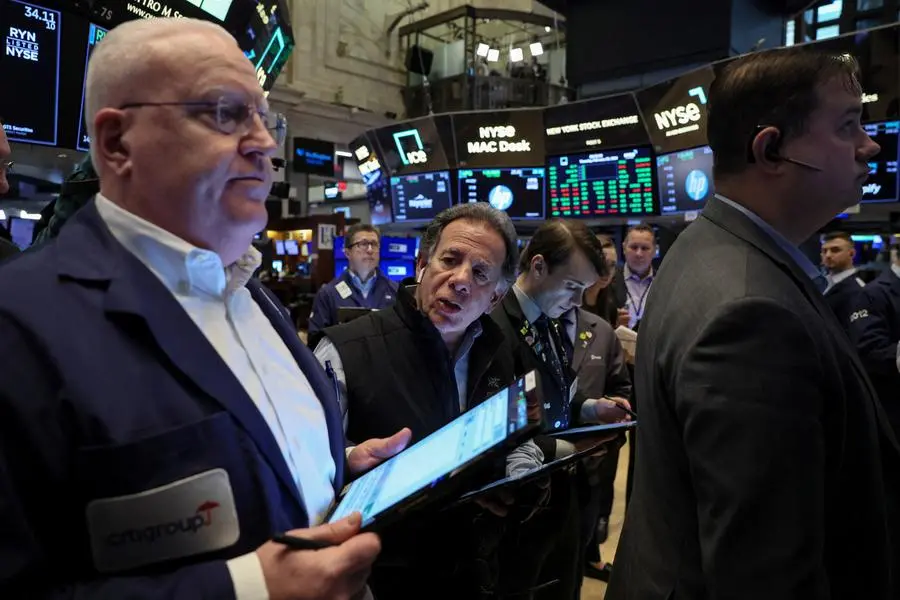PHOTO
An investor scramble to lock in returns before the Federal Reserve cuts rates is expected to sustain a rally in the U.S. corporate bond market into the second quarter, with one strategist saying it may touch levels not seen in three decades.
Credit markets are being overwhelmed by a buying frenzy, as investors bet the Fed will engineer a soft landing, taming inflation without causing a recession, and then cut interest rates later this year to support growth.
On March 21, the premium paid by companies over Treasuries, called credit spreads, on investment grade rated and junk-rated bonds touched their tightest levels in two years - at 91 basis points and 305 basis points, respectively.
Large bond investors such as insurance companies and pension plans are seeing an influx of money from their clients looking to capitalize on higher interest rates, leading them to seek corporate bonds, credit strategists said. But there may not be enough new issuance to go around.
In the first quarter, for example, investment grade companies raised a record $538 billion – that’s 40% of the $1.3 trillion of bond supply that was expected for the entire year, according to data from research firm Informa Global Markets. In a sign of strong demand, new offerings have been three to four times oversubscribed on average.
Morgan Stanley’s credit strategist Vishwas Patkar likened the current market to conditions in the mid-1990s, when after four cuts in 1995, the Fed kept rates high for an extended period of time. "Credit remained very resilient, and spreads hit their modern era tights of 56 basis points even as rates were higher," he said.
Patkar said there was a chance spreads could go as low as 75 basis points, levels not seen since the 1990s, if a soft-landing was achieved. Earlier this month, he moved his base case year-end spread target to 95 basis points from 125 basis points.
He's not alone. Bank of America strategists expect spreads to tighten to around 80 basis points over the next month, closer to the 77 basis point level touched in 2021. They are, however, sticking to a 6-month spread target of 100-120 basis points.
MISPRICING RISK?
The strong demand for their debt is good news for companies as it allows them to fund themselves more cheaply. But some investors warned that tighter spreads also mean they are getting paid less for the risk they take on when buying such debt.
The difference between the credit spreads on bonds rated BBB and those with A ratings were near all-time lows, which meant credit investors are not charging for macro risks – including the risk of a hard landing for the U.S. economy, said Hans Mikkelsen, credit strategist at TD Securities in a report on March 15. Mikkelsen has a six-month spread target at 130 basis points.
"As an investor, it is hard to argue there is a lot of value left at these spread levels, so we are underweight corporate credit," said John Lloyd, lead for the multi-sector credit strategies at Janus Henderson Investors.
Mike Griffin, co-head of corporate and municipals teams at global investment management firm Conning, said his firm was minimizing downside risks by diversifying their investments in a variety of asset classes.
To avoid being caught with bonds that could not be sold when the market turns, they invested largely in debt issued by high quality companies, he said.
STRONG DEMAND
Despite the risks, Wall Street strategists say the market's tailwind is likely to continue for now.
Insurance companies are buying corporate bonds to match a rise in liabilities, as higher interest rates spurred increased sales of annuities, or insurance contracts that pay out a regular income stream.
Total U.S. annuity sales reached a record-high $385.4 billion in 2023, jumping 23% year over year, according to industry body LIMRA.
Insurance companies and pension funds "are looking to immunize their liabilities with high coupon paying assets like fixed income, with the latter group potentially looking to rotate out of equities," Conning’s Griffin said.
Also adding to demand are re-investments of coupons being paid by companies on their existing bonds.
Goldman Sachs estimates that investment-grade and high-yield rated bonds will generate total coupon payments of $463 billion in 2024. If those payments were all reinvested, it would absorb 77% of the $600 billion of net issuance expected this year, it said.
"Strong technicals remain in the driver’s seat as demand for investment-grade credit remains overwhelming and supply is starting to ease off the record pace," JPMorgan strategists wrote in a report on Tuesday.
The bank lowered its year-end spread target for investment-grade rated bonds by 30 basis points to 95 basis points.
(Reporting by Shankar Ramakrishnan; editing by Paritosh Bansal and Anna Driver)












